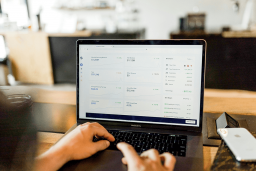Mobile banking is rapidly growing in popularity worldwide, financial institutions are introducing more and more new features, and some projects are turning into super applications. Revolut is a famous mobile banking app example. It generated £636 million in revenue in 2021, a 143% increase yearly. Revolut had 20 million users as of June 2022, and 1.4 million use the app daily.
In this article, we will discuss the mobile banking revolution and Ukrainian neobanks, what features banking apps should have, and how much it costs to develop a mobile banking app.
Key points
What is mobile banking?
Internet banking (online/web banking) is a type of remote banking that provides access to accounts and banking transactions at any time via the Internet (using gadgets such as a computer, tablet, or smartphone).
Mobile banking is a type of online banking that provides access to accounts and banking transactions through a mobile app installed on a smartphone.
Mobile banking revolution
The rapid development of FinTech has caused a real revolution in mobile banking. Now even the most conservative financial institutions realize they must keep up with new opportunities to stay competitive.
Thus, the times when the main bank-customer touch points were through financial centers are long gone. Mobile banking has supplanted in-person banking. This trend became even more pronounced during the COVID-19 pandemic when people were forced to stay home. Some stats:
- Statista states that 93% of UK adults used online banking in 2022.
- According to a 2023 Forbes Advisor U.S. Consumer Banking Statistics study, roughly three in four Americans (78%) prefer banking via a mobile app or website to banking in person.
- According to Forrester analytics, 40% of UK online adults would consider banking with a provider that does not have any branches.
- Rapyd study shows that almost half (43%) of Britons make mobile purchases weekly, underscoring electronic wallets’ growing popularity.
Mobile technology is the new battleground. With the development of the FinTech industry, the number of digital banks is rapidly increasing, the number and quality of products offered are growing, and the general public’s interest is increasing.
Consumers around the world are eager to pay with their smartphones and watches. Banks must accelerate product development and innovation in their mobile apps to meet changing consumer habits and remain competitive with FinTech challengers and digital banks.
Now even Elon Musk plans to turn the social network Twitter into a bank by creating a super-app. FinTech marketers are aiming to maximize the functionality of their mobile apps.
American and European FinTech companies should look at China and what happened with WeChat and AliPay to see how successful the super-app approach can be if applied correctly, but the reality is that getting to that point is incredibly difficult.
Ukrainian neobanks are excellent examples for American and European FinTech startups
Mobile banking in Ukraine is very young, but it is developing at a pace that foreign financial institutions admire. For example, PrivatBank was the first in the world to create mini payment terminals (mini POS), allow people to enter internet banking with a QR code, and launch online encashment. Compared to the Ukrainian FinTech, foreign financial products seem more regulated, slow, and too conservative.
Many progressive digital banks operating in Ukraine are moving the domestic payment system forward. Among them:
- Monobank (operating under a banking license from Universal Bank)
- Bank Vlasni Rachunok (a digital project of Bank Vostok, Mastercard, and Fozzy Group)
- Neobank (operating under license from ConcordBank and based on Concord Fintech Solutions, the first open FinTech ecosystem in Ukraine)
- Izibank and Sportbank (mobile neobanks-partners of TASKOMBANK)
Many services of these digital projects are basic (utility payments, commission-free mobile top-ups, issuance of credit funds, deposit opening, etc.). Still, each application has its features and unique offers. For example:
- Bank Vlasni Rachunok offers customers to recharge (without fees) at Silpo cash desks and pay in these supermarkets (as well as in Le Silpo) with loyalty points
- Sportbank is a universal financial partner for all those who love sports and active leisure, giving 10% cashback on sports goods
- Monoinvest application allows users to trade stocks (a brokerage account is opened free of charge)
- Ukrainian applications UkrGasBank, FUIB, and Monobank allow users to buy military bonds, and Privat24 also enable them to buy domestic government loan bonds.
Not only did the war not break Ukraine’s banking system, but it also led to financial institutions introducing new progressive products.
For example, in September 2022, Unex Bank, Mastercard, and FinTech startup Weld Money launched weld card – Ukraine’s first cryptocurrency card based on Debit Mastercard. It is linked to a cryptocurrency wallet on the Weld Money platform, added to Apple Pay and Google Pay. It allows paying in cryptocurrencies (without the need to convert them into fiat currency) for goods and services.
What features should mobile banking apps have?
Mobile banking apps aim to provide convenient and secure access to financial services for their users. While the specific features can vary based on the bank and app design, here are some common features that banking apps often offer:
- Account management. Users should be able to view their account balances, transaction history, and account details. The app should allow users to manage multiple accounts, including checking, savings, credit cards, loans, and investments.
- Funds transfer. Banking apps should enable users to transfer funds between their accounts, pay other individuals or businesses, and set up recurring or scheduled transfers.
- Bill payment. Users should be able to pay bills directly from the app. This includes adding and managing billers, viewing and paying bills, and setting up bill payment reminders.
- Card management. The app should allow users to manage their debit and credit cards. This includes activating or deactivating cards, setting spending limits, reporting lost or stolen cards, and reviewing card transactions.
- Mobile deposits. Many banking apps offer the convenience of depositing checks by taking photos using the mobile device’s camera. This feature allows users to securely deposit checks into their accounts without visiting a physical branch.
- ATM/Branch locator. The app should provide an ATM and branch locator feature that helps users find the nearest ATM or bank branch for their banking needs.
- Notifications and alerts. Users should receive real-time notifications and alerts related to their account activities, such as low-balance alerts, transaction alerts, and security notifications for suspicious activities.
- Personal finance management. Some banking apps include personal finance management features like expense tracking, budgeting tools, categorizing spending, and setting financial goals. These features help users manage their finances effectively.
- Enhanced security features. Banking apps should implement strong security measures to ensure the security of transactions and user data. This may include biometric authentication (fingerprint or facial recognition), two-factor authentication, encryption, and fraud detection.
- Account customization. Users appreciate the ability to customize their app experiences, such as setting preferences, organizing accounts, and choosing personalized themes or layouts.
Our development team has very diverse expertise in numerous domains. For example, we worked with the American startup Veer from Silicon Valley. When Veer was looking for a contractor, one of the main requirements was data security compliance. SoloWay Tech specialists met these requirements. You can find more in our Veer Case Study article.
How much does it cost to develop a mobile banking app?
Developing a robust and secure mobile banking app requires a significant investment. While it’s challenging to provide an exact figure without specific project details, here are some cost factors to consider:
- Development team. The cost of hiring developers and designers will depend on their location, experience, and hourly rates. Rates can vary significantly across different regions and countries. At SoloWay Tech, we have high-versed developers with mobile banking development expertise.
- App features and complexity. The more features and complex functionalities you require in the app, the more development time and effort will be needed, resulting in higher costs. Advanced features like biometric authentication, online payment gateway integration, and data encryption can add to the development expenses.
- Design and user experience. Investing in a well-designed and user-friendly interface is crucial for a banking app. The complexity of the app’s design, including wireframing, UI/UX design, and graphic assets, impact the development cost.
- Development approach. Choosing between native development (iOS and Android apps built separately) or cross-platform development (using frameworks like React Native or Flutter) will have cost implications. Native development tends to be more time-consuming and costly compared to cross-platform development.
- Integration with backend systems. Mobile banking apps require integration with existing banking systems, APIs, security protocols, and third-party services. The complexity and customization required for these integrations influence the development cost.
- Testing and security. Rigorous testing, including functional testing, security testing, and performance testing, is crucial for a banking app. The overall cost is affected by allocating time and resources for comprehensive testing and security measures.
- Maintenance and updates. The cost of maintaining and updating the app post-launch should also be considered. Ongoing updates are necessary to ensure compatibility with new OS versions, security patches, and evolving industry standards.
The cost of developing a mobile banking app can range from $30 000 to $100 000 or even more, depending on the abovementioned factors.
Conclusion
Developing a mobile banking app requires careful consideration and planning to ensure a secure, user-friendly, and feature-rich experience for customers. We have outlined the various stages of the development process, including planning, design, development, testing, and deployment. We have also highlighted the importance of key features such as account management, funds transfer, bill payment, card management, and security measures.
If you need a reliable mobile banking app development partner, feel free to contact us right now!




